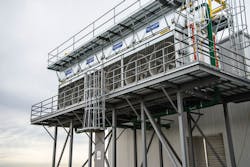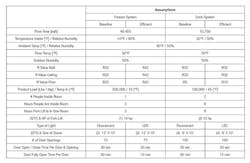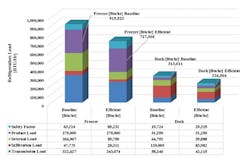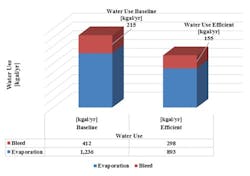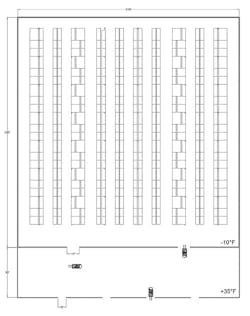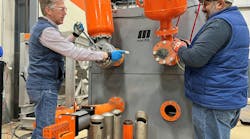For food and beverage processing facilities, the industrial refrigeration system is key to operations. It can also be the key investment and factor in a facility’s operational efficiency and ongoing costs for maintenance and energy use. Being environmentally responsible is becoming more important for industries across the board, and in recent years, the field of industrial refrigeration engineering has seen an array of advances in more efficient equipment and more sustainable refrigerants.
However, in much of the industry, engineering practices that have been the industry standard for years are slowing the adoption and use of these new technologies. By employing older, typical engineering approaches in the design of new systems, production facilities are not only unnecessarily wasting energy and resources, which also impacts the environment, but these businesses that rely on refrigeration are wasting their cold hard cash.
Table 1. Assumptions for refrigeration case study | Click to view larger
The potential to save energy, resources and significant amounts of money requires more than simply using new technologies. It requires an entirely new approach to engineering the whole system with which a facility operates, not just the refrigeration system and components themselves.
Engineering opportunity
True innovation in improving refrigeration systems – making them more efficient, sustainable and cost-effective – involves multiple factors. Of course, engineers need to know the baseline requirements that the facility must meet and account for the typical local environmental/seasonal conditions. However, a key to innovating a new approach lies in changing how refrigeration system engineers fundamentally think about designing their systems.
Rather than viewing the job as designing and installing systems to refrigerate an industrial space, it is helpful to instead view the challenge as removing heat from the building to cool it. (In this article, we’ll also refer to energy (heat) coming into the system as “load”). With this approach, the factors impacting the refrigeration system significantly widen in scope to include the entire facility and all the factors that contribute heat to the system, insulate it from heat gain, and which allow heat to enter the system – such as doors.
If the actual engineering mindset should be that of removing heat from the building, then any factor that contributes heat to the system should be considered. More load means a larger, more expensive refrigeration system, more chemicals, more maintenance time, more sewage waste and more electricity to operate. To reap the benefits, facility owners, operators and managers must work closely with a progressive refrigeration engineering partner at the outset (in the engineering phase) to produce plans for a system that is precisely designed to provide exactly what the facility needs.
Design refrigeration loads for the refrigerated facility in the case study |Click to view larger
This new approach is environmentally responsible and achievable without sacrificing any reliability, performance or durability of the refrigeration system. Once a processing facility looks at the full scope of return on investment (ROI), the power savings and the huge bottom line savings, this load shedding becomes an attractive solution.
The LED solution
To demonstrate the concept, it is necessary to look at one significant heat factor for processing facilities: interior lighting. Older facility lighting – typically halogens, high-pressure sodium and metal halides – put out a tremendous amount of energy in the form of heat. Modern, industrial-grade LED lighting systems on the other hand, positively impact the performance and efficiency of a refrigeration system. They emit heat at an approximately 90-percent slower rate than conventional lighting systems, and for the bottom line, LEDs use less than half the power of conventional lighting.
Costs and savings of the refrigeration system and lighting in the case study | Click to view larger
Because older lights are slow to warm up to full illumination, especially in cold facilities, they generally are on 24/7, year after year. The accumulated heat output, and the energy expense to operate them, is enormous. LEDs instantly fire up to full illumination and can be on only when the facility is in use. Whether turned on by motion-sensors, timers or manually, having the LEDs operate only when the facility is actually in use further reduces the heat output and the amount of horsepower needed in the refrigeration system engine room.
LEDs save even more money by lasting thousands of hours longer than halogens or fluorescents, and they are water resistant, shatterproof and lose little illumination power over long periods of time. Therefore, the ongoing replacement cost savings and maintenance time (and safety) are added benefits.
Case study: Energy & bottom line savings in industrial refrigeration
Consider a hypothetical example of a relatively small cold storage facility with a dock – see Table 1 for assumptions. From the table, it is clear this facility is listed with typical specifications used in the industry today, compared with a refrigeration system engineered at the outset with additional load-shedding factors accounted for in the design. All of the following factors impact the eventual engineering requirements for the refrigeration system, reducing the amount of component horsepower required and the overall size of the entire system because far less heat needs to be removed from the facility.
First, assume instead of using 6-inch insulated metal panels, the facility upgraded to 8-inch panels for the freezer and increased the amount of insulation in the floor for both the freezer and dock areas. The additional insulation helps cut down on the transmission heat loads coming into the space through the building envelope. This upgrade in insulation reduces the transmission loads into the facility as a whole by 25 percent.
Further, assume in an effort to be more efficient, the facility installed quick-opening doors tied to motion sensors so they automatically open and close, minimizing external heat coming into (or refrigerated air leaving) the system. This is factored into in Table 1, which shows a cutback on infiltration load by 40 percent in the facility as a whole. Another factor the facility must consider is whether to employ variable frequency drives on both the evaporator and the condenser fan motors. This more energy-efficient option cuts in half the power use of the fan, and the evaporator fan motors give off less heat as well.
Water use of the refrigeration system in the case study | Click to view larger
With these upgrades, the design refrigeration load is cut by nearly 30 percent, and the refrigeration system engineering can account for that with a smaller, less expensive, more efficient design. Savings on this front will run across the board. Smaller evaporators are required since there is less heat to take out of the space, and smaller piping sizes are needed because they transport less refrigerant. Since those pipes transport less refrigerant, smaller compressors are needed to operate, and a smaller condenser is required because there is less heat to reject.
Upgrades also save other expenses and environmentally impactful resources. Because the system is rejecting less heat through a smaller condenser, the amount of water used in the evaporative condenser is smaller, and the chemicals used to treat the water in that condenser are reduced accordingly. This translates into a conservative savings of 47 percent for the refrigeration system consumables as a whole.
Furthermore, because the facility refrigeration system is smaller, there is less refrigerant charge in the system. If it were an ammonia system, that would mean a less toxic refrigerant on site and, theoretically, a lower cost of insurance for the facility as well as potentially less stringent regulations regarding the operation of the system. Due to the smaller refrigeration equipment and smaller charge, installation fees are reduced as an added bonus.
More efficiency, more savings
In addition to the heat reductions saving electricity, water and sewer, a further factor to consider is that energy trusts, grants and other government subsidies and incentives can significantly defray costs associated with load-shedding improvements and refrigeration system upgrades. In the case of LED lighting upgrades, for instance, the material costs can be largely rebated by energy trust groups to the point that the lighting system itself is nearly free. The remaining capital costs are paid for within months with the power savings themselves. Of course, the energy savings and reduced power and maintenance costs will continue to accrue to the bottom line year after year.
Plan view of refrigerated warehouse used in the case study | Click to view larger
The numbers speak for themselves. By considering the overall impact of load factors in the facility and upgrades to the refrigeration system, a food and beverage processing facility can cut its operational costs to nearly half, and for a brand new refrigeration system installation, there would be less refrigeration equipment installed and less refrigerants required, saving significantly on upfront costs and reducing the use of potentially environmentally hazardous refrigerants. There also will be a higher level of system safety because the refrigerant charge is smaller (especially in the case of ammonia).
While the operational advantages and the cost savings are significant, processing facilities and their companies will also claim a less tangible, but still very real, benefit in terms of sound environmental stewardship and corporate responsibility. Facilities will see reduced requirements for how much chemical refrigerant is needed – coupled with an emerging shift toward non-toxic refrigerants like CO2 – less use of materials of every type from steel to insulation, reduced water use and sewage waste, and of course, a much smaller electricity carbon footprint.
Having a modern, highly efficient system across all the refrigeration, load-shedding factors that exist in a processing facility will benefit employees, maintenance staff and managers, the bottom line, and the planet. It is an approach that each company that contemplates building a new refrigerated processing facility or upgrading/refitting an existing one should consider, evaluate and employ.
Steve Jackson is cofounder and president of PermaCold Engineering Inc., an award-winning industrial refrigeration engineering, installation, and maintenance firm founded in 1993 in Portland, Oregon. PermaCold is recognized for its expertise in designing systems for optimum efficiency, dependability and value and provides customers with preventative maintenance and repairs, retrofitting services, consulting on efficiency and regulatory compliance, and more. PermaCold focuses on engineering energy-efficient, environmentally safe systems and is the industry leader in green industrial refrigeration.
